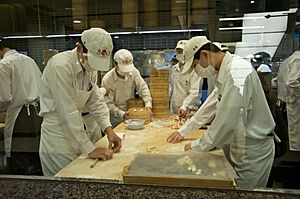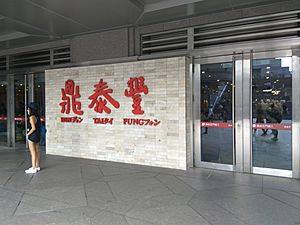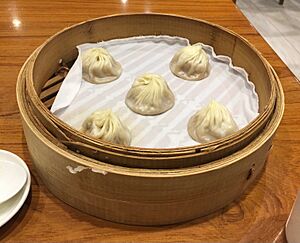Din Tai Fung facts for kids
 |
|

Xiaolongbao made to order at the restaurant behind glass pane
|
|
|
Native name
|
鼎泰豐
|
|---|---|
| Chinese Taiwanese |
|
| Industry | Restaurant |
| Founded | 1958 |
| Founder | Yang Bingyi |
| Headquarters | , |
|
Area served
|
Australia, Hong Kong, Indonesia, Japan, Mainland China, Macau, Malaysia, Philippines, Singapore, South Korea, Thailand, UAE, UK, USA |
| Products | Xiaolongbao |
| Din Tai Fung | |||||||||||||||
|---|---|---|---|---|---|---|---|---|---|---|---|---|---|---|---|
| Traditional Chinese | 鼎泰豐 | ||||||||||||||
| Simplified Chinese | 鼎泰丰 | ||||||||||||||
|
|||||||||||||||
Din Tai Fung is a famous restaurant chain from Taiwan. It's known for its delicious Taiwanese cuisine, especially its steamed dumplings called xiaolongbao.
This popular restaurant started in Taipei, Taiwan. Today, you can find Din Tai Fung restaurants all around the world! They have locations in places like Australia, China, Japan, Singapore, the United States, and many more countries.
Contents
The Story of Din Tai Fung

Din Tai Fung was started by a man named Yang Bing-yi. He moved to Taiwan and worked for ten years at a shop that sold cooking oil. Later, he wanted to start his own business to support his family.
In 1958, Yang Bing-yi and his wife, Lai Penmei, opened their own cooking oil shop. They named it Din Tai Fung. This name was a mix of his old workplace's name ("Heng Tai Fung") and their new oil supplier's name ("DinMei Oils").
From Oil Shop to Dumpling Heaven
Around 1970, things changed. People started buying cooking oil in cans, which made it harder for small shops to sell oil. To keep their business going, the owner of Yang's old workplace suggested a new idea. He told them to start making and selling steamed buns, especially xiaolongbao, in half of their shop.
These xiaolongbao became super popular! They were so loved that the shop stopped selling oil completely. By 1972, Din Tai Fung had become a full-time restaurant, famous for its amazing dumplings. The very first restaurant is still in Taipei on Xinyi Road.
Growing Around the World
Din Tai Fung quickly became famous beyond Taiwan.
- In 1996, the first international restaurant opened in Tokyo, Japan.
- In 2000, the first North American restaurant opened in Arcadia, California, USA.
- In 2005, they opened their first branch in Jakarta, Indonesia.
- In December 2018, the first European restaurant opened in London, England.
Like many businesses, Din Tai Fung faced challenges during the COVID-19 pandemic. Some locations had to close, but many others continue to operate and serve their famous food.
Why Din Tai Fung is Famous
Din Tai Fung is known all over the world for its special xiaolongbao. These dumplings are made with very thin wrappers and have exactly 18 folds! It's a sign of how carefully they are made.
The restaurant has even received special awards. In 2009, one of their Hong Kong restaurants earned a Michelin star. This is a very high honor for restaurants, showing how good their food and service are. Other Din Tai Fung locations have also been recommended by the Michelin Guide, proving their excellent reputation.
See also
- List of Chinese restaurants
- List of restaurants in China
- List of restaurants in London
- List of restaurant chains in Australia
- List of companies of Taiwan
- Bafang Dumpling



